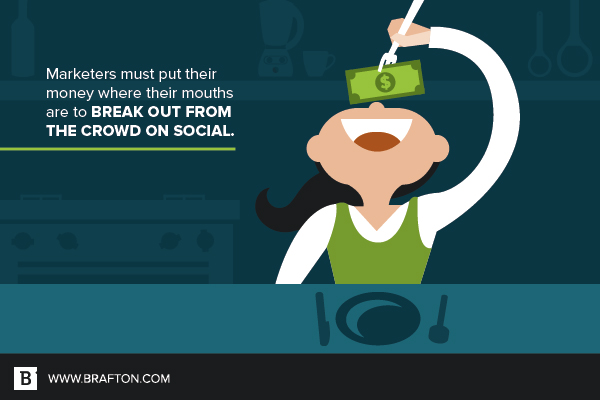Once upon a time, social media’s greatest allure for marketers was its price tag. Businesses could engage eager audiences free of charge, boosting brand awareness with a Facebook post instead of dedicating thousands of dollars to costly print advertisement campaigns or television commercials.
Well, the good times rolled… and rolled… and rolled away.
Social media is now a pay-to-play space, just like those pesky publishing and TV markets it once helped undercut. Organic posting is still important, but heightened competition means marketers must put their money where their mouths are to break out from the crowd.
Of course, determining how social media fits into your marketing budget is difficult to do when you’re unsure how much spend is necessary. Allow us to lend a hand.
In order to illustrate best practices in social spending, Brafton tasked two of its brightest minds – Associate Director of Social Media Allie Stone and Associate Social Media Manager Erin Hancock – with creating an initial plan of attack for a fictional client.
The client in question is a B2B software provider. While the client doesn’t have a huge marketing budget, they’re willing to make a reasonable investment in a social media marketing strategy.
Please allow Allie and Erin to walk us through how they’d help this client succeed.

Planning
Before any work can be done, objectives must be outlined.
“The first step is to discuss what the client’s goals are for this particular campaign,” Erin said. “Do they want to get leads or simply spread the word about their brand?”
Furthermore, how is the client measuring the value of the campaign? What specific metrics are they focusing on?
For the sake of argument, we’ll say this client wants leads.
Next up is audience. What are the client’s buyer personas? Where are these individuals most active online?
Allie recommended researching which social platforms typically bring in the most traffic and conversions for the client’s industry, as well studying any social media campaigns the client has run in the past to determine what worked and what didn’t.
Platforms
Since the client operates in the B2B space, LinkedIn and Twitter were obvious choices.
“LinkedIn offers a qualified professional audience you can’t get anywhere else,” Allie said. “It would allow us to target by specific job titles, skills and even groups. Twitter would be good to utilize because of its remarketing capabilities and ability to target by companies’ competitors.”
That latter point means the client could advertise to the followers of other players in its space in addition to people who follow industry influencers.
“There is constant change in the software industry,” Allie said. “Twitter allows your company to join the conversation about these changes as well as provide a level of customer service to current clients.”
Cost per click on Twitter ranges from $0.10 to $3. LinkedIn, with its more qualified user base, features a CPC of between $5 and $12.
The team recommended starting with $500 a month on Twitter and $100 a day on LinkedIn. Changes should be made to this budget after analyzing results following the first few months of strategy implementation.
 Strategy
Strategy
Choosing the platforms to focus on and how much to spend on them is one thing; knowing how to leverage them is another entirely. In this case, the ultimate objective is lead generation.
“We would work to educate potential customers, then nurture them down the sales funnel,” Allie said. “On Twitter, we could promote blogs to educate the audience about the brand.”
Using the Twitter pixel, a snippet of code used on website pages to assist with tracking, Brafton’s social strategists could then remarket to that audience using an asset that is more bottom of the funnel.
“On LinkedIn, it’s best to have an asset highlighting a product or service and how it can provide value for the targeted audience,” Allie said. “Perhaps a case study or whitepaper. We want to be pushing people to a gated page to take advantage of the qualified audience in hopes of collecting their information. Blogs can also be thrown into the mix to introduce a brand to the audience. If you are promoting a blog, you want to include calls to action to bring readers further into your website and hopefully to product or service pages.”
Targeting
Arguably the most important factor for social media marketing spending is ad targeting. This allows the client to zero in on the most desirable sales prospects.
“For LinkedIn, I would target first by by industry and job title,” Erin said. “Then I would look at different companies. On Twitter, I would target by followers and have the client provide a list of key influencers so we can then target their followers. Otherwise we would create our own list of influencers. A secondary option is to target by interests and keywords.”
ROI
Next up is measuring results.
“Showing return on investment depends on the client’s goals and how ads are optimized,” Erin said. “For example, if the goal is whitepaper downloads that capture lead information, we can optimize the ad for that.”
Ad conversions can be tracked in Google Analytics using UTM codes and Google Analytics goals.
“If the client can attach a monetary value to a whitepaper download, we are better able to show if these downloads yielded profit, broke even, or worst, lost some money,” Allie said. “We evaluate the success of each campaign after its run and make adjustments, but often times we like to look at ROI after month three. If we haven’t hit a groove, then something must be off.”
It’s also important to remember that social ROI can be particularly difficult to track. While an ad on social media may assist in a conversion, it may not receive full credit depending on how a website visitor ultimately converts.
“We still consider this a win, because if they never came across the social ad, they wouldn’t have converted down the line,” Allie continued. “It’s definitely worth looking at the path toward conversions in Google Analytics.”

Organic
Budgets bring limitations, but there are still numerous organic opportunities within social media marketing.
“Organic posting and having that presence is a good way to spread the word for free,” Erin said. “While we can’t target like that, posting daily can show your followers you’re engaged.”
Allie recommended utilizing Twitter cards to collect users’ information organically. It’s also smart to tag businesses in Twitter posts, send content assets to thought leaders through direct messages and generally work to increase engagement with social influencers.
“Strike up conversations to get your brand presence out there,” Allie said. “By using a personal profile for LinkedIn Pulse and discussion posts, you can organically promote assets and get in touch with any connections you might have within your personal network.”
Obviously every social media marketing strategy will be different, changing based on goals and overall marketing budget. However, some things remain the same, including the need for careful planning, strategic platform usage and ROI analysis.
The days of making a marketing splash on social for free may be over, but with the right gameplan and experienced strategists, it’s still very much possible to see social’s benefits on a budget.





